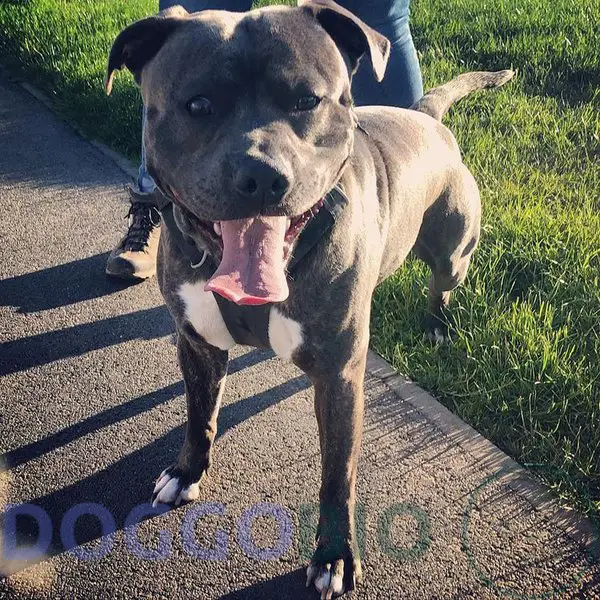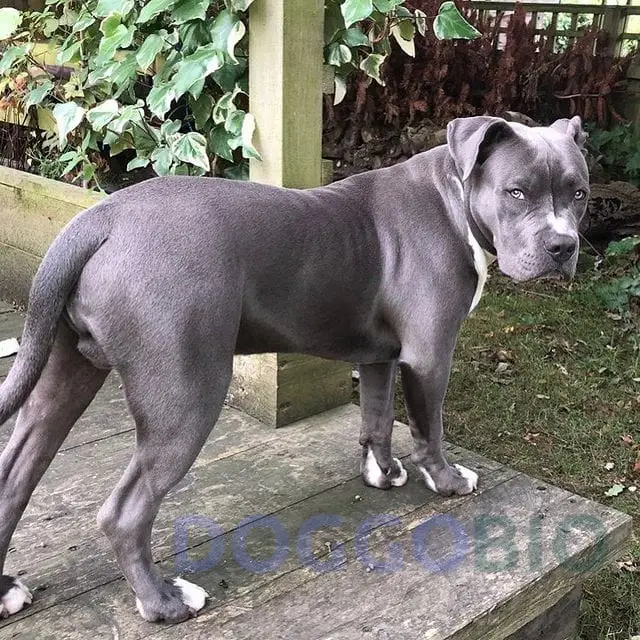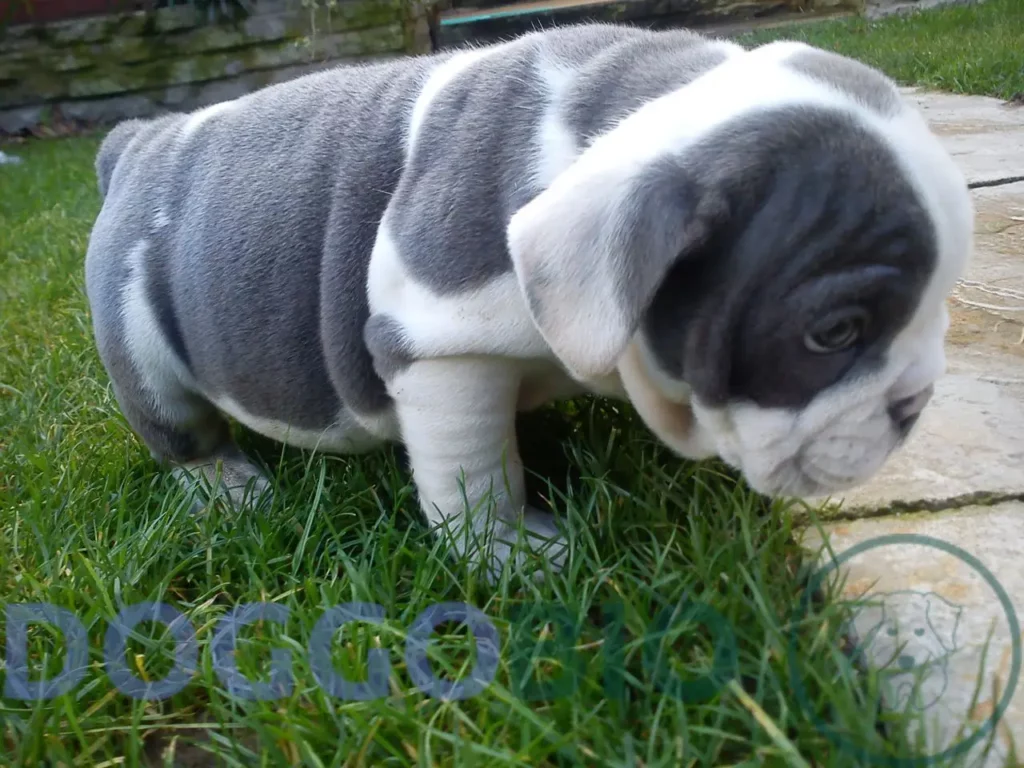The American Blue Bulldog, also known as the Old Country Bulldog, is a large and powerful dog breed with a rich history in the United States. The breed was initially developed as a working dog, specifically a catch dog for wild boar and guard dogs.
Today, the American Blue Bulldog is a loyal and protective family companion known for their courage, strength, and intelligence. This breed is characterized by its muscular build, broad head, and distinctive blue coat color, resulting from a recessive gene.
In this article, we will explore the history, temperament, and characteristics of the American Blue Bulldog and provide information on their care and training.
A Brief Overview of Blue American Bulldog
| Purity | Purebred |
| Purpose | Companion dog |
| AKC Recognition | No |
| Size | Large |
| Weight Range | 60 – 125 pounds |
| Height Range | 20 – 27 inches |
| Coat Colors | Blue, Bluish Gray |
| Lifespan | 10 – 15 years |
| Average Puppy Costs | $2,000 – $5,000 |
What is a Blue American Bulldog?

Blue American Bulldogs are a unique and rare variation of the American Bulldog breed. These dogs have a gorgeous bluish-gray coat color caused by a rare recessive gene that dilutes the black pigment.
While the blue coloration is not recognized as a standard for the breed by most kennel clubs, these dogs have gained popularity in recent years due to their distinctive appearance. It’s important to note, however, that responsible breeding practices should always prioritize the health and temperament of the dogs over their coat color.
Origins and History of American Bulldog
What causes the blue coloration in these majestic creatures? I wonder no more because it’s all due to a dilution gene. This gene fades the black color into a stunning blue-grey hue. But hold on tight because this dilution gene is a recessive trait, meaning both parents must carry it for their offspring to inherit the striking blue coloration.
But wait, there’s more! To get the blue coloration in American Bulldogs, it had to be introduced from another breed. That’s right, folks, the Blue American Bulldog has a unique history that sets it apart from other Bulldogs.
What Does a American Blue Bulldog Look Like?
Behold, the majestic Blue American Bulldog! These dogs are a sight to behold with their chiseled muscles, large heads, and imposing jaws. Their chests are deep and broad, perfect for housing their mighty hearts, and their shoulders are toned and athletic, ready to take on any challenge.
One of the most noticeable features of the Blue American Bulldog is its flat, wrinkled face, which gives them an air of wisdom and authority. Their ears droop forward, almost like they are in deep contemplation, while their tails are broad at the base and taper towards the tip, giving them a unique and stylish appearance.
Size, height, and weight
The size, height, and weight of a Blue American Bulldog can vary depending on their gender and age.
These dogs are considered significant in size and typically reach their full height at around 18 months of age. However, their chest can continue to fill out with exercise and proper nutrition.
Male Blue American Bulldogs are generally taller and heavier than their female counterparts.
| Age | Weight (Males) | Height (Males) | Weight (Females) | Height (Females) |
| 3 months | 25 – 43 lbs | 12 – 16 inches | 24 – 40 lbs | 12 – 16 inches |
| 6 months | 45 – 75 lbs | 17 – 22 inches | 40 – 55 lbs | 17 – 20 inches |
| 9 months | 75 – 110 lbs | 22 – 25 inches | 55 – 65 lbs | 20 – 23 inches |
| 12 months | 110 – 125 lbs | 25 – 27 inches | 65 – 90 lbs | 23 – 25 inches |
Coat colors and types
Blue American Bulldogs, with their bluish-gray coat color, are not recognized as a standard color by most kennel clubs. Solid blacks, Merle, lilac, chocolate, and tricolor are not admitted either.
White is the only accepted standard color for the American Bulldog breed, but brown, black, tan, or brindle markings on a white base coat can be considered acceptable coat variations.
Temperament and Personality
While Blue American Bulldogs are generally known for their loyalty and protectiveness, they can also be stubborn and independent-minded. Therefore, it is crucial to socialize your furry companion from an early age to ensure it becomes a well-adjusted and well-behaved pet.
Additionally, positive reinforcement training techniques are often recommended to foster obedience and good behavior in Blue American Bulldogs.
Is Blue American Bulldog a good fit for families?
Blue American Bulldogs make excellent family pets! They’re a great choice for active households and can get along swimmingly with children and other animals as long as they’re socialized early on.
That said, Blue American Bulldogs can be aloof around unfamiliar critters and become easily riled up in the presence of unruly pets. It’s essential to keep a watchful eye on them when they’re playing with young kids to avoid any mishaps.
Are Blue American Bulldogs aggressive?
No. Blue American Bulldogs are not naturally aggressive. They are known to be protective of their owners and can act aggressively when they perceive a threat or intruder.
However, this aggression is a response to a specific situation and not a general characteristic of their temperament. They are often used as guard dogs because of their protective nature and ability to assess threats.
Proper training and socialization can help ensure that their protective instincts are well-balanced and controlled.
Training

Training American Blue Bulldogs can be challenging, but it is crucial for the dog’s development and behavior. It is best to start teaching them early to establish good habits and a routine.
Since Blue American Bulldogs are known to be stubborn, using firm commands with lots of positive reinforcement is essential for successful training. Consistency is also crucial in maintaining the dog’s progress.
While training, it is essential to keep the sessions fun and engaging. Blue American Bulldogs are receptive to exercise and thrive in an environment where they can interact with their owner.
Exercise Requirements
Blue American Bulldogs require significant exercise to maintain their physical and mental health. They need at least one to two hours of rigorous physical activity daily to help them burn off excess energy and maintain their physique.
Breaking up exercise into two sessions is recommended, one in the morning and another in the late afternoon. This helps keep the Blue American Bulldog stimulated and active throughout the day. However, it is essential to note that every dog is unique and may require more or less exercise depending on their age, health, and temperament.
Living Conditions
American Blue Bulldogs can thrive in various living conditions as long as they receive ample exercise. They may resort to destructive behavior and excessive barking without adequate physical activity.
However, leaving them alone for extended periods could result in separation anxiety and unwanted behaviors. Their brachycephalic faces make them vulnerable to breathing difficulties during extreme temperature changes.
Grooming and Cleaning
Maintaining the hygiene and grooming of your American Bulldog Blue is essential to keep them healthy and happy.
- While their short coat requires minimal grooming, ensuring that the folds in their skin are free from moisture is crucial to prevent bacterial infections.
- These dogs are known to drool, so wiping their mouths with a towel is necessary. And if you need to bathe them, use a dog shampoo that can cleanse and moisturize their skin and coat.
- When it comes to brushing their teeth, daily brushing is ideal, but 3-4 times a week should suffice. Use dog toothpaste with an enzymatic formula that helps control tartar formation and maintain healthy teeth and gums. Plus, the non-foaming agent makes it safe for them to swallow.
- Short nails are also crucial for your furry friend’s walking gait, so consider using a dog nail grinder with a precise diamond bit grinder and a quiet motor if they have had bad experiences with clippers.
| Grooming Needs | Grooming Frequency |
| Bathing | Twice a month |
| Brushing | Once a week |
| Teeth Brushing | 3 to 4 times per week |
| Nail Trimming | As needed |
Are Blue American Bulldogs Hypoallergenic?
No. Blue American Bulldogs are not hypoallergenic. If you have allergies, this breed may not be the best choice for you.
While they may not shed as much as some other breeds, they still produce allergenic dander. Additionally, Blue American Bulldogs are known to drool, which can also be a source of allergens. Their saliva can spread on surfaces like furniture, carpets, and clothing, potentially triggering allergies in sensitive individuals.
Food and Diet
When it comes to feeding your American Blue Bulldog, ensuring they’re getting the right amount of food is essential. Feeding them only once daily can lead to severe digestive issues, such as bloating. The recommended daily food intake for an adult American Blue Bulldog is around 3 to 4 cups, which should be divided into two meals to avoid tummy troubles.
But the quality of food matters just as much as the quantity. Ensure that their diet balances protein, fats, and carbohydrates to keep up with their active lifestyle. Opt for high-quality dog food that contains real meat as the primary ingredient and avoids artificial preservatives, colors, or flavors.
Also, remember that different life stages and health conditions require different dietary needs. Always consult your veterinarian to determine the best diet plan for your furry friend, whether a growing puppy, an active adult, or a senior with specific health needs.
Common Health Issues
However, there are some common health issues that Blue American Bulldogs may experience throughout their lifetime.

1. Hip Dysplasia
Hip dysplasia is a common health problem for Blue American Bulldogs and other bull breeds. This happens because their bones grow faster than their muscle tissues, leading to the loosening of the hip joints and the malformation of the socket and ball joints in the hip area. If you notice your Blue American Bulldog limping or swaying gait, it could be a sign of hip dysplasia.
2. Congenital Heart Disease
Blue American Bulldogs can be affected by congenital heart disease, including subaortic and pulmonic stenosis. Look for signs such as a pot-bellied appearance and fainting, which could indicate an underlying heart condition.
3. Skin Issue
The skinfolds of the Blue American Bulldog can put him at risk for developing skin diseases caused by bacteria or yeast infections. Fleas and allergies also make it worse for our furry friends! And it’s not just skin redness and lesions that we have to keep an eye out for. Hair loss and dandruff can also indicate that our puppy is experiencing some severe skin problems!
4. Eye Problems
Bull breeds like the Blue American Bulldog are at higher risk of eye problems than other dogs. This breed has common eye issues: cherry eye, entropion, and corneal ulcers. Look out for symptoms like a cloudy appearance and excessive itching, and make sure to get your furry friend checked out by a vet if you notice anything unusual.
5.Von Willerbrand Disease
Von Willebrand Disease, a genetic bleeding disorder due to a lack of a clotting protein in the blood, is another condition that Blue American Bulldogs may be prone to. Symptoms of this disease include persistent bleeding and nosebleeds.
How Long Does a Blue American Bulldog Live?
On average, these dogs have a lifespan of 12 years. Still, with proper care and attention, some can live as long as 16 years, adding to the perplexity of the subject.
While some dogs may live longer than the average lifespan, several variables can impact the lifespan of your Blue American Bulldog. These variables include breed, disease susceptibility, and the quality of care.
Despite the numerous factors that can affect their lifespan, Blue American Bulldogs are considered one of the healthiest breeds, making them an excellent choice for those seeking a long-term companion. However, to ensure that your dog lives a long and healthy life, it is crucial to provide proper care, including regular veterinary check-ups, exercise, and a healthy diet.
How Much is The Price of a Blue Bulldog?
Want to own a Blue American Bulldog? Well, you should be prepared to fork out a few dollars! Adopting a Blue American Bulldog will cost you about $300 while purchasing one from a breeder can set you back anywhere from $1,000 to $6,000.
But don’t worry; these puppies are worth every penny you spend on them! Their high price reflects their popularity and the fact that they are challenging to breed. So if you’re ready to invest in a loyal and devoted companion, a Blue American Bulldog might be your perfect furry friend!
Is Blue American Bulldog Right For Me?
A crucial aspect to consider when adopting a Blue American Bulldog is the commitment you are willing to devote to training this breed. Daily training is necessary to ensure your dog doesn’t assert itself as the household alpha or exhibit aggressive behavior.
Moreover, if you provide the Blue American Bulldog with adequate physical exercise daily, then it will make an excellent companion for you. Failure to provide them with the necessary physical stimulation could result in destructive behavior, which might not be ideal for some owners.
Therefore, before bringing a Blue American Bulldog into your life, assess whether you can meet their needs and devote time and effort to care for them.
List of dogs that are similar to Blue American Bulldog
- Chocolate French Bulldog
- Black English Bulldog
- How Long Do Bulldogs Live?
- Do English Bulldogs Have Tails?
- American Bulldog Johnson
- Mini French Bulldog
- Do French Bulldogs have Blue Eyes?
- Fluffy French Bulldog
- Grey French Bulldog
Frequently Asked Questions
1. Are Blue American Bulldogs good with kids?
Yes, Blue American Bulldogs are good with kids! They can be surprisingly gentle, despite their tough exterior.
However, staying vigilant and supervising your puppy’s interactions with your little ones is essential. Blue American Bulldogs are naturally protective and may take their guardianship role seriously. This could lead to them becoming overprotective and potentially aggressive towards perceived threats.
Therefore, it’s crucial to start socializing and training them early to ensure they are comfortable and friendly around people of all ages.
2. Are American Bulldogs suitable for first-time dog owners?
Yes. American Bulldogs, including Blue American Bulldogs, can be suitable for first-time dog owners. They have several characteristics that make them a good choice for novice dog owners.
They typically have lower exercise and grooming requirements compared to some other breeds, which can be more manageable for beginners. Additionally, they are often easy to train, which can be helpful for someone new to dog ownership.
However, it’s essential to provide proper training, socialization, and care to ensure a happy and well-behaved pet, regardless of your experience level as a dog owner.
3. Can Blue American Bulldogs swim?
Yes. Blue American Bulldogs can swim, but they are not natural swimmers like some other dog breeds. Due to their large faces and powerful jaws, they may find it challenging to stay afloat for extended periods.
However, with proper training and supervision, they can learn to swim safely. It’s crucial to be cautious when introducing them to water and always supervise them to prevent accidents.
4. Are Blue American Bulldogs rare?
Yes. Blue American Bulldogs are considered rare in the world of American Bulldogs. They are less common than the more traditional white American Bulldogs because most breeders adhere to the standards set by kennel clubs, which favor the white coat color. This rarity can make them more challenging to find compared to other variations of the breed.
Conclusion
In conclusion, the American Blue Bulldog is a fascinating and loyal breed with a rich history and unique characteristics. This breed is known for its strength, courage, and intelligence, making it an excellent family companion for those willing to give them the time and attention they deserve.
The American Blue Bulldog’s striking blue coat color and muscular build make them a distinctive and impressive breed, but their loyal and protective nature truly sets them apart.
If you are considering adding an American Blue Bulldog to your family, be sure to do your research and find a reputable breeder who can help you provide the best possible care and training for your new companion. With the proper care, love, and attention, the American Blue Bulldog can make an excellent and devoted companion for many years.

Pingback: Do English Bulldogs Have Tails? The Captivating Story 2023
Pingback: How Long Do French Bulldogs Live? Nurturing a Lifetime 2023
Pingback: Chocolate French Bulldogs: A Comprehensive Overview 2023
Pingback: Fluffy French Bulldog: A Powerful Elixir of Love & Laughter 2023
Pingback: Blue Eyed French Bulldog: Your New Love 2023
Pingback: Mini French Bulldogs: Unleash Your Heart's Love for Petite 2023